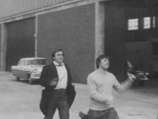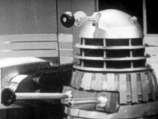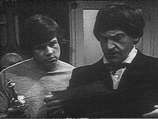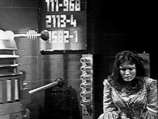 |
|
Chasing After the TARDIS
|
|
 After saying their goodbyes to Polly Wright and Ben Jackson in 1966, The Doctor and Jamie McCrimmon watch helplessly as a lorry, with the TARDIS onboard, being driven away from Gatwick Airport. They question the hangar foreman. But The Doctor grows suspicious of him and decides to follow him when he leaves. This eventually leads them to an antique shop run by Edward Waterfield. The Doctor instantly realises that there is something very odd about the shop as it seems to sell Victorian antiques that look very much as if they were brand new. After saying their goodbyes to Polly Wright and Ben Jackson in 1966, The Doctor and Jamie McCrimmon watch helplessly as a lorry, with the TARDIS onboard, being driven away from Gatwick Airport. They question the hangar foreman. But The Doctor grows suspicious of him and decides to follow him when he leaves. This eventually leads them to an antique shop run by Edward Waterfield. The Doctor instantly realises that there is something very odd about the shop as it seems to sell Victorian antiques that look very much as if they were brand new.
 What The Doctor does not realise is that Edward Waterfield is being coerced by the Daleks – one of which materialises in a secret room at the back of the shop through a time machine, and exterminates an employee called Kennedy. Investigating the back of the shop, The Doctor and Jamie discover Kennedy’s body but they trigger a booby trap and gas pours into the room. Edward Waterfield then appears and drags the unconscious Doctor and Jamie into the time machine. What The Doctor does not realise is that Edward Waterfield is being coerced by the Daleks – one of which materialises in a secret room at the back of the shop through a time machine, and exterminates an employee called Kennedy. Investigating the back of the shop, The Doctor and Jamie discover Kennedy’s body but they trigger a booby trap and gas pours into the room. Edward Waterfield then appears and drags the unconscious Doctor and Jamie into the time machine.
 They wake up to find that they have been transported back 100 years to 1866, and are in the house of Theodore Maxtible, Edward Waterfield's partner. The Doctor learns that the two had been trying to invent a time machine using mirrors and static electricity. Then the Daleks emerged from their time cabinet and took Edward Waterfield's daughter, Victoria Waterfield, hostage and forced Edward Waterfield to travel a century forward in time to lure The Doctor into a trap by stealing the TARDIS. Edward Waterfield is obviously fearful for his daughter's safety and his own, but Theodore Maxtible seems to be going along with the Daleks for his own reasons. They wake up to find that they have been transported back 100 years to 1866, and are in the house of Theodore Maxtible, Edward Waterfield's partner. The Doctor learns that the two had been trying to invent a time machine using mirrors and static electricity. Then the Daleks emerged from their time cabinet and took Edward Waterfield's daughter, Victoria Waterfield, hostage and forced Edward Waterfield to travel a century forward in time to lure The Doctor into a trap by stealing the TARDIS. Edward Waterfield is obviously fearful for his daughter's safety and his own, but Theodore Maxtible seems to be going along with the Daleks for his own reasons.
 | | A Dalek Materilises |
|
 The Daleks then threaten to destroy the TARDIS unless The Doctor helps them to conduct an experiment so as to isolate the ‘Human Factor’, the unique qualities of human beings that have allowed them to consistently resist and defeat the Daleks. Once The Doctor has isolated the Human Factor they plan to implant it into three Daleks, which will then become the precursors of a race of ‘super’ Daleks, with the best qualities of humans and Daleks. To that end, the Daleks get The Doctor to test Jamie by sending him to rescue Victoria, who is being kept captive in the house. The Doctor is strangely co-operative with the Daleks, manipulating Jamie into the rescue mission but not telling him the nature of the test nor the dangers he will confront. The Daleks then threaten to destroy the TARDIS unless The Doctor helps them to conduct an experiment so as to isolate the ‘Human Factor’, the unique qualities of human beings that have allowed them to consistently resist and defeat the Daleks. Once The Doctor has isolated the Human Factor they plan to implant it into three Daleks, which will then become the precursors of a race of ‘super’ Daleks, with the best qualities of humans and Daleks. To that end, the Daleks get The Doctor to test Jamie by sending him to rescue Victoria, who is being kept captive in the house. The Doctor is strangely co-operative with the Daleks, manipulating Jamie into the rescue mission but not telling him the nature of the test nor the dangers he will confront.
 Jamie manages to rescue Victoria, but she is taken prisoner again and transported through the time cabinet. The Doctor, observing how Jamie accomplished the rescue, distils the Human Factor, but continues to harbour suspicions that there is more to the experiment than just this. Once the Human Factor is implanted in the three Daleks, they become completely human in personality and seem almost child-like, although The Doctor realises their mentalities will mature quickly. The Doctor's decides to christen the three Daleks ‘Alpha’, ‘Beta’ and ‘Omega’. However, despite being ‘human’ Daleks they still follow Dalek orders and return through the time cabinet to Skaro, the Daleks' home planet. Jamie manages to rescue Victoria, but she is taken prisoner again and transported through the time cabinet. The Doctor, observing how Jamie accomplished the rescue, distils the Human Factor, but continues to harbour suspicions that there is more to the experiment than just this. Once the Human Factor is implanted in the three Daleks, they become completely human in personality and seem almost child-like, although The Doctor realises their mentalities will mature quickly. The Doctor's decides to christen the three Daleks ‘Alpha’, ‘Beta’ and ‘Omega’. However, despite being ‘human’ Daleks they still follow Dalek orders and return through the time cabinet to Skaro, the Daleks' home planet.
 | | The Doctor and Jamie |
|
 Meanwhile, Edward Waterfield has discovered that Theodore Maxtible has betrayed them all to the Daleks, hoping that he will be able to learn the secret of transforming base metal into gold. However, Theodore Maxtible, who has travelled to Skaro through the mirror cabinet, is discovering just how ruthless the Daleks are and how empty their promises can be. Back on Earth The Doctor, Jamie and Edward Waterfield find themselves locked out of the time cabinet, but they manage to use the Daleks' own short-range time machine to make the journey to Skaro just before a Dalek bomb destroys Theodore Maxtible's house. Meanwhile, Edward Waterfield has discovered that Theodore Maxtible has betrayed them all to the Daleks, hoping that he will be able to learn the secret of transforming base metal into gold. However, Theodore Maxtible, who has travelled to Skaro through the mirror cabinet, is discovering just how ruthless the Daleks are and how empty their promises can be. Back on Earth The Doctor, Jamie and Edward Waterfield find themselves locked out of the time cabinet, but they manage to use the Daleks' own short-range time machine to make the journey to Skaro just before a Dalek bomb destroys Theodore Maxtible's house.
 The trio find their way into the Dalek city and are brought before the imposing Dalek Emperor, who reveals the true reason behind the experiments and the capture of the TARDIS. By isolating the human factor, The Doctor more importantly has succeeded in isolating the ‘Dalek Factor’ - the qualities that make the Daleks mindless killing machines. In addition, the Emperor intends to use the TARDIS to spread the Dalek Factor throughout human history, turning all humanity into Daleks. The trio find their way into the Dalek city and are brought before the imposing Dalek Emperor, who reveals the true reason behind the experiments and the capture of the TARDIS. By isolating the human factor, The Doctor more importantly has succeeded in isolating the ‘Dalek Factor’ - the qualities that make the Daleks mindless killing machines. In addition, the Emperor intends to use the TARDIS to spread the Dalek Factor throughout human history, turning all humanity into Daleks.
 Meanwhile, after being shown a machine that can turn base metal into gold, Theodore Maxtible is tricked into walking through an archway that instead infuses him with the Dalek Factor, mentally turning him into a Dalek. The Doctor is also lured through the archway, apparently converting him. However, The Doctor feigns his conversion, and instead secretly plants a device on the archway. Meanwhile, after being shown a machine that can turn base metal into gold, Theodore Maxtible is tricked into walking through an archway that instead infuses him with the Dalek Factor, mentally turning him into a Dalek. The Doctor is also lured through the archway, apparently converting him. However, The Doctor feigns his conversion, and instead secretly plants a device on the archway.
 | | Victoria is Held Captive |
|
 As the Daleks are hunting for the three ‘human’ Daleks, who are have been heard to question orders, The Doctor suggests that all the Daleks should pass through the conversion archway so that the ‘human’ Daleks will once again be infused with the Dalek Factor. As the Daleks are hunting for the three ‘human’ Daleks, who are have been heard to question orders, The Doctor suggests that all the Daleks should pass through the conversion archway so that the ‘human’ Daleks will once again be infused with the Dalek Factor.
 As the first batch of Daleks goes through the archway, The Doctor is able to free the others and to explain to them that the archway could not affect him as it was calibrated for humans and as he is not one it won’t affect him. He also reveals that he has swapped the Dalek Factor for the Human Factor so that when the Daleks pass through the archway they will all be converted to become ‘human’ Daleks and so start to question the Emperor’s orders. He then tells his friends to escape to the surface. As the first batch of Daleks goes through the archway, The Doctor is able to free the others and to explain to them that the archway could not affect him as it was calibrated for humans and as he is not one it won’t affect him. He also reveals that he has swapped the Dalek Factor for the Human Factor so that when the Daleks pass through the archway they will all be converted to become ‘human’ Daleks and so start to question the Emperor’s orders. He then tells his friends to escape to the surface.
 As the converted Daleks spread through the city civil war breaks out as they battle with the Emperor's Black Daleks. During the battle Edward Waterfield sees an enemy Dalek approaching and fire at The Doctor. He shields The Doctor but in doing so receives a fatal wound. Before he dies he asks The Doctor to take care of his daughter. As the converted Daleks spread through the city civil war breaks out as they battle with the Emperor's Black Daleks. During the battle Edward Waterfield sees an enemy Dalek approaching and fire at The Doctor. He shields The Doctor but in doing so receives a fatal wound. Before he dies he asks The Doctor to take care of his daughter.
 With the battle between the two Dalek factions intensifying the converted Daleks eventually reach the Emperor where he is attacked and exterminated thus causing a huge explosion to rip through the Dalek’s city. The Doctor though is able to reach the surface and meet up with Jamie and Victoria. It is then that he breaks the news of Edward Waterfield's death. He tells Victoria that her father’s death was not in vain as he believes that this is the final end of the Daleks. The Doctor then announces to Jamie that Victoria will be joining them and so they all head for the TARDIS and safety. With the battle between the two Dalek factions intensifying the converted Daleks eventually reach the Emperor where he is attacked and exterminated thus causing a huge explosion to rip through the Dalek’s city. The Doctor though is able to reach the surface and meet up with Jamie and Victoria. It is then that he breaks the news of Edward Waterfield's death. He tells Victoria that her father’s death was not in vain as he believes that this is the final end of the Daleks. The Doctor then announces to Jamie that Victoria will be joining them and so they all head for the TARDIS and safety.
|